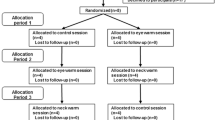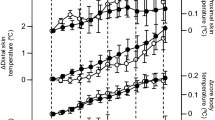Abstract
Sleep onset is best predicted by an increase in the amount of hand and foot warming relative to more proximal areas (Krauchi, Cajochen, Werth, & Wirz-Justice, 1999; Krauchi, Cajochen, Werth, & Wirz-Justice, 2000). We assessed if an increase in sleepiness would also occur if the distal limbs were warmed through an external manipulation. In this study, 5 min before participants (N = 11) attempted to fall asleep on a multiple sleep latency test (Carskadon et al., 1986) their hands and feet were immersed in water heated to either 42 °C or heated to the temperature of the warmest limbs. The results show no difference in sleep latency between the warm and control water conditions. There was a decrease in sleep latency in the control and warm water conditions compared to the initial (noncounterbalanced) baseline multiple sleep latency test. Further studies are necessary to determine if any degree of limb warming hastens sleep onset.
Similar content being viewed by others
References
Achoff, J., & Wever, R. (1981). The circadian rhythms of man. In J. Aschoff (Ed.), Biological rhythms: Handbook of behavioral neurobiology (pp. 311–331). New York: Plenum.
Borbely, A. (1982). A two process model of sleep regulation. Human Neurobiology, 1(3), 195–204.
Bunnell, D., Agnew, J., Horvath, S., Jopson, L., & Wills, M. (1988). Passive body heating and sleep: Influence of proximity to sleep. Sleep, 11, 210–219.
Bunnell, D., & Horvath, S. (1985). Effects of body heating during sleep interruption. Sleep, 8, 274–282.
Campbell, S., & Broughton, R. (1994). Rapid decline in body temperature before sleep: Fluffing the physiological pillow? Chronobiology International: The Journal of Biological & Medical Rhythm Research, 11(2), 126–131.
Carskadon, M., Dement, W., Mitler, M., Roth, T., Westbrook, P., & Keenan, S. (1986). Guidelines for the Multiple Sleep Latency Test (MSLT): A standard measure of sleepiness. Sleep, 9(4), 519–524.
Holm, S. (1979). A simple sequentially rejective multiple test procedure. Scandinavian Journal of Statistics, 6, 65–70.
Horne, J., & Moore, V. (1985). Sleep EEG effects of exercise with and without additional body cooling. Electroencephalography and Clinical Neurophysiology, 60, 33–38.
Horne, J., & Staff, L. (1983). Exercise and sleep: Body heating effects. Sleep, 10, 383–392.
Jordan, J., Montgomery, I., & Trinder, J. (1990). The effects of afternoon body heating on body temperature and slow wave sleep. Psychophysiology, 27, 560–566.
Krauchi, K., & Cajochen, C. (1997). A relationship between heat loss and sleepiness: Effects of postural change and melatonin administration. Journal of Applied Physiology, 83(1), 134–139.
Krauchi, K., Cajochen, C., Werth, E., & Wirz-Justice, A. (1999). Warm feet promote the rapid onset of sleep. Nature, 401, 36–37.
Krauchi, K., Cajochen, C., Werth, E., & Wirz-Justice, A. (2000). Functional link between distal vasodilation and sleep-onset latency? American Journal of Physiology, Regulatory, Integrative and Comparative Physiology, 278, R741-R748.
Krauchi, K., & Wirz-Justice, A. (1994). Circadian rhythm of heat production. heart rate, and skin and core temperature under unmasking conditions in men. American Journal of Physiology, Regulatory, Integrative and Comparative Physiology, 267, R819-R829.
Lack, L., & Gradisar, M. (2002). Acute finger temperature changes preceding sleep onsets over a 45-h period. Journal of Sleep Research, 11, 275–282.
Raymann, R., Drosopoulos, S., Van Someren, E., Collin, S., Vis, R., Van Krevelen, G., et al. (2002). Effect of core and skin temperature manipulations on sleep onset latency. Journal of Sleep Research, 11(Suppl. 1), 188–189.
Rechtschaffen, A., & Kales, A. (1968). A manual of standardized terminology, techniques and scoring system for sleep stages of human subjects. Brain Information Service/Brain Research Institute, University of California, Los Angeles, CA.
Seidel, W., & Dement, W. (1981). The multiple sleep latency test: Test-retest reliability. Sleep Research, 10, 284.
Zwyghuizen-Doorenbos, A., Roehrs, T., Schaefer, M., & Roth, T. (1988). Test-retest reliability of the MSLT. Sleep, 11(6), 562–565.
Author information
Authors and Affiliations
Corresponding author
Additional information
This work was supported in part by a grant from The City University of New York PSC-CUNY Research Award Program and an American Psychological Association Dissertation Science Award.
Rights and permissions
About this article
Cite this article
Ebben, M.R., Spielman, A.J. The effects of distal limb warming on sleep latency. Int. J. Behav. Med. 13, 221–228 (2006). https://doi.org/10.1207/s15327558ijbm1303_5
Issue Date:
DOI: https://doi.org/10.1207/s15327558ijbm1303_5




